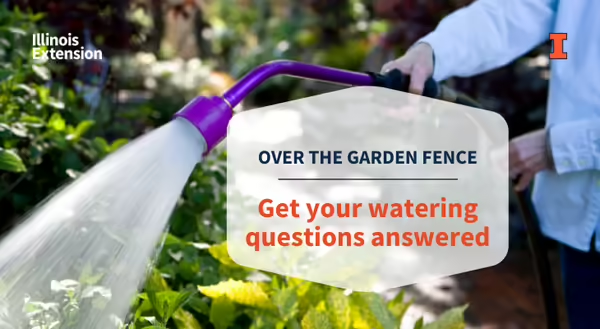
Watering plants may seem easy, but it can inspire a lot of questions – When? How much? What is the best way? What kind of watering attachment? Can I use harvested water?
How and when to water
One thing to always remember, if watering by hand, is to water the soil, not the plant. Why? Foliar fungal diseases need wet plant leaves to develop and cause plant damage, so dry leaves are preferred.
If overhead watering is going to be done – such as with lawns or large plantings – then get out there early in the day so the foliage dries off quickly once you are done. Fungal diseases require the leaves to remain wet for several hours to infect leaf tissue. The adage “water on rising temperatures” is so true.
What device to use
Now that we know watering the soil is the preferred way, how do we apply water comes up. The goal is to soak the soil rather than splash the soil around while we water. Those foliar diseases we just talked about overwinter in the ground, so splashing water droplets with soil particles on the foliage is not a good thing. Methods to reduce splash include: mulching bare areas, watering at a slow rate of flow, and using a true breaker on a watering wand to reduce the water pressure from the garden hose.
In my book, the best combination is to turn down the spigot AND use a water breaker; the water will just “bubble” or flow quietly. However, there are also other ways, such as drip irrigation options for the home garden.
When they need water most
This question will depend on what you are watering. All seeds need that moisture to start the germination process. Transplants (annuals, vegetables, perennials, etc.) need that water to get through transplant shock and quickly develop a strong root system for the rest of the summer.
Vegetables will need to be watered regularly if you want good looking fruits, seed pods, and root crops. Critical dry periods for vegetables are:
- Crucifers: head development
- Sweet corn: silking and tasseling
- Cucurbits: fruit development
- Tomatoes and peppers: fruit development
- All beans: flowering through pod fill
Annual flowers need water to establish quickly and begin their summer bloom show. Perennials will be working on establishing a permanent root system the first year and will typically begin to bloom the second or third year, depending on the size of the transplant.
Those small fruits like strawberries, brambles, currants, and gooseberries behave just like our perennials. Once the root system is established, flowers and fruits follow. For the fruits to fill well, be sure your watering matches production.
How much water they need
Between Mother Nature and us, our plants should get about 1 to 1 ½ inches of water every 7 to 10 days, depending on the growth stage and fruit development. For overhead watering, an easy way to figure that out is to time how long it takes to fill a traditional tuna can with water using your sprinkler. (No tuna can? Try a 1-inch deep dish or container or place a 1-inch mark in an empty butter tub or another smaller container heading to the recycling bin.) That filling time will be equivalent to about one inch of water applied. For watering by hose or can, remember to water the soil, not the plant. Overall, use the best method of watering you can, or what conditions allow.
How to use rainwater
Harvested water, like from rain barrels, can be used in various areas in the yard, but should be avoided for the vegetable garden. The main reason being health concerns, such as potential transmittable disease and possible contamination from roofing materials. Save that collected water for your lawn, flowers, trees, and shrubs.
About the author: Richard Hentschel’s expertise extends across several subject areas with specialties in lawn care, fruit tree production, woody ornamentals, and home and community gardening. During his 45-year career in horticulture and agriculture, Hentschel became a well-known and respected expert for commercial and homeowner audiences, industry organizations, and media. He retired from University of Illinois Extension in April 2022 with nearly 30 years of service as a Horticulture Specialist and Educator in northern Illinois.